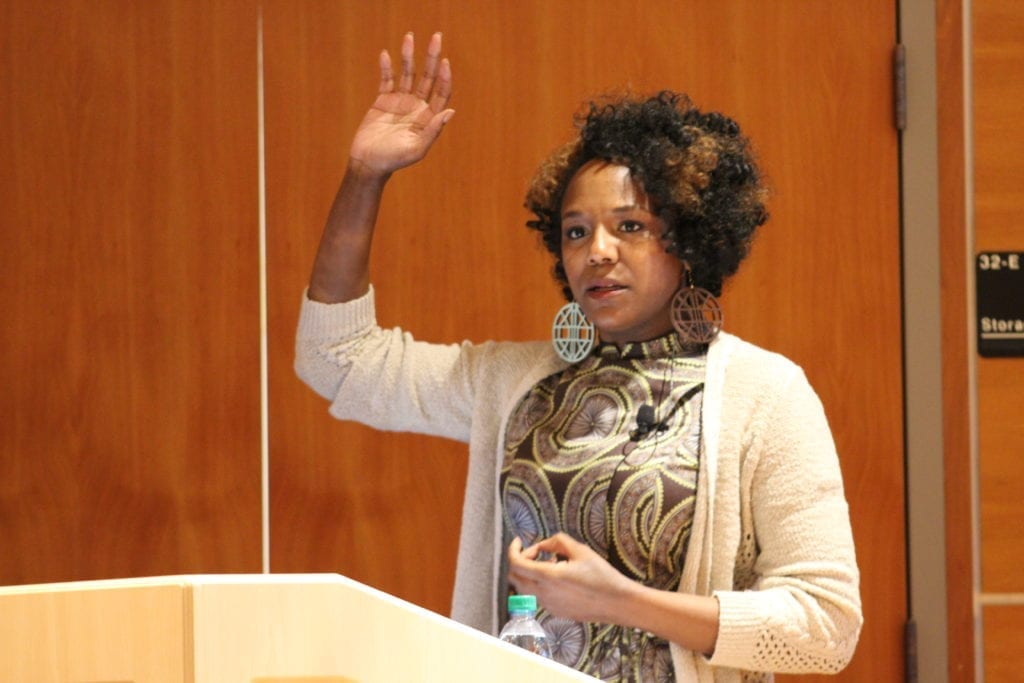Black Lives Matter activist urges ‘social consciousness,’ action in divisive times
Bree Newsome reflected on her role in removing the Confederate flag from South Carolina’s Capitol in 2015. She addressed the gravity of symbolism in society, calling the flag emblematic of slavery, Jim Crow laws and racial terror.

Newsome urged audience members to determine what their contribution to mankind would be at her "Tearing Hatred from the Sky" lecture in Alumni Memorial Building on Monday, Feb. 27.
Bree Newsome urged students to determine their own contribution to society and choose consciousness in the face of difficult issues by drawing from lessons from her own past on Monday, Feb. 27.
“I realized I took my rights for a granted,” the artist-turned-activist, said. “I asked myself what I was doing to assure that I could keep my rights and that those rights would exist for those after me.”
Her consciousness was nudged into existence while standing in the old Slave Mart museum in Charleston, S.C.
On June 27, 2015 Bree Newsome’s consciousness led her to perform a historic feat. After scaling a four-foot tall spiked fence, she hoisted herself up a 30-foot flagpole to unhook the Confederate flag that had flown atop the South Carolina statehouse since 1961 symbolizing a “social order of white supremacy.” With the aid of James Tyson, a white organizer strategically positioned at the base of the pole disguised as a construction worker, she was able to unhook the flag and repel to the ground safely.
“Not now or has it ever been about this particular flag…or any flag, or any symbol. Rather, it is about abolishing hatred and oppression in every form,” Newsome said.
She praised the courage of Tyson as well as the other activists she planned the protest with. According to Newsome, Tyson used his privilege to be an ally, something she urged all audience members to be.
Newsome’s definition of an “ally” means that someone can recognize their privilege and know when to reject it or capitalize on it. Tyson, for example, threw himself between the flagpole and the police threatening to tase Newsome, halfway up the pole, saying that if they electrocuted her, they would electrocute him as well.
“The most important thing to really think about and understand is how much blood has been spilled in this cause for racial equity,” Newsome said, pointing out countless photos and listing names of multi-ethnic individuals who have shown great “moral courage” in history.
Newsome debunked the common misconception that the mass shooting of nine Emanuel African Methodist Episcopal Church members ignited the controversy. Newsome called it a mistaken notion, insisting that the massacre only reshifted focus back to the issue by thrusting it into the national spotlight. The issue has always been present, it just went unnoticed and ignored until Dylann Roof took the lives of the church-goers.
“It took the blood of nine to awaken the consciousness of a nation,” Newsome said.
Despite the monumental step that South Carolina made to officially remove the flag, Newsome thinks there is still work to be done. Without the practice of freedom, symbols of strength and freedom will be nothing but dead monuments and fabric. She highlighted laws and practices that are systematically disenfranchising the black population. Mass incarceration, gentrification of neighborhoods, police brutality, generational poverty, poor education funding and voter identification laws are all issues at hand.
Newsome identifies her role as a grassroots leader in the Black Lives Matter (BLM) movement as service leadership about “sacrifice for others” and “giving for grace.” Aware that BLM is commonly dubbed a leaderless movement, she called it a “leader-full” movement with a collective responsibility to end discrimination. Newsome urged listeners to not let the purpose of any movement get lost in the process—to not be so focused on the “how” that they lose sight of “why.”
“This is a generation of awakening,” Newsome said. “One that will and already has, in many ways, changed (sic) the world. The only question to ask yourself is ‘what will be my contribution?'”
“It was a blessing to have her even take the time to come and educate us. As an African American woman, to see her and know what she did freely, I guess…to see her sacrifice is amazing. She’s just like me — She went to a collegiate university and took these strides for things she felt important. That’s a beautiful thing,” president of the University of Tennessee National Association for the Advancement of Colored People, Kaylyn Harris, said.
Newsome concluded the lecture by reiterating her definition of consciousness. “It means to be aware what a fantastic blessing it is to be alive in this moment, even though sometimes it feels like the world is falling apart. [Consciousness means] to be a human being, to have the power to create and shape a world where there is no hunger and thirst, where there is no violence and oppression, to be children of God, to be as beautifully diverse as every other species yet blessed with an awareness of ourselves as an endlessly imaginative creative force on this earth.”
Edited by Kaitlin Flippo
Featured image by McKenzie Manning

